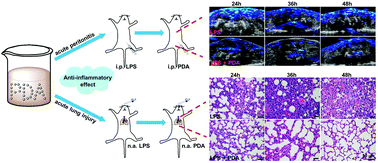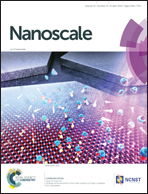Polydopamine nanoparticles for the treatment of acute inflammation-induced injury†
Abstract
Nanotechnology-mediated anti-inflammatory therapy is emerging as a novel strategy for the treatment of inflammation-induced injury. However, one of the main hurdles for these anti-inflammatory nano-drugs is their potential toxic side effects in vivo. Herein, we uncovered that polydopamine (PDA) nanoparticles with their structure and chemical properties similar to melanin, a natural bio-polymer, displayed a significant anti-inflammation therapeutic effect on acute inflammation-induced injury. PDA with enriched phenol groups functioned as a radical scavenger to eliminate reactive oxygen species (ROS) generated during inflammatory responses. As revealed by in vivo photoacoustic imaging with a H2O2-specific nanoprobe, PDA nanoparticles remarkably reduced intracellular ROS levels in murine macrophages challenged with either H2O2 or lipopolysaccharide (LPS). The anti-inflammatory capacity of PDA nanoparticles was further demonstrated in murine models of both acute peritonitis and acute lung injury (ALI), where diminished ROS generation, reduced proinflammatory cytokines, attenuated neutrophil infiltration, and alleviated lung tissue damage were observed in PDA-treated mice after a single dose of PDA treatment. Our work therefore presents the great promise of PDA nanoparticles as a biocompatible nano-drug for anti-inflammation therapy to treat acute inflammation-induced injury.

- This article is part of the themed collection: Nanoscale 10th Anniversary: Top Authors


 Please wait while we load your content...
Please wait while we load your content...